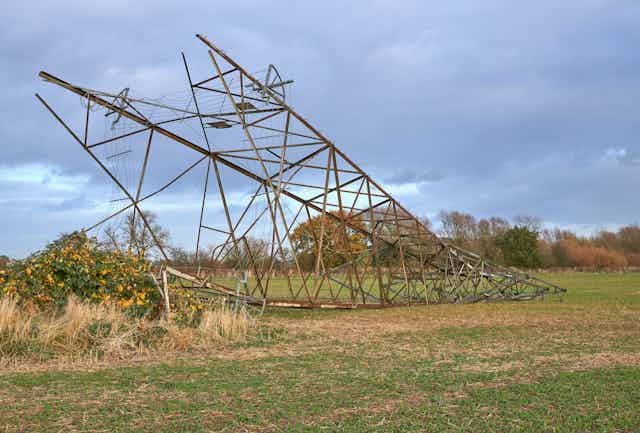Storm Arwen, described by the UK’s Met Office as “one of the most powerful and damaging winter storms of the last decade”, hit the east coast of Scotland and northern England in late November 2021. Wind gusts of over 90 mph and fallen trees caused widespread damage to energy infrastructure. More than one million homes lost power and some were still disconnected over a week later.
Arwen was followed by storms Dudley, Eunice and Franklin in February 2022. These storms had similarly devastating impacts on the UK’s power supply. During Storm Eunice, areas of southeastern England were left without water for five days as water treatment facilities had no power.
Later that year, the UK experienced its most intense heatwave ever. Temperatures as high as 40°C pushed the electricity grid to the brink of failure.
Meteorologists and climate scientists call events like these extreme weather. This means that weather is at the extremes of – or even beyond – the historical record for that location and type of event.
The UK is no stranger to extreme weather. But evidence suggests that climate change may be increasing the frequency and intensity of such events. This highlights the need to ensure the UK’s energy system is prepared for and resilient to future weather extremes.

Power supply problems
The most common type of damage is to power lines that take electricity from where it is generated to homes and businesses. This often involves overhead lines overheating in hot weather or being blown over and hit by trees during a storm.
Electricity substations, which reduce the voltage of electricity from power lines to make it safe to use, can also be flooded following heavy rainfall or storm surges. Flooding reduces their capacity and can even stop them working entirely. For example, 100,000 people in Lancaster had their electricity supply cut off in 2015 when a flood damaged the city’s main electricity substation.
Regional energy blackouts can occur when too many power lines or substations go down. Reconnection can then take several days (or even weeks) as network operators tend to wait until the severe weather has passed before attempting repair.
Extreme temperatures also cause energy demand to surge as people struggle to cool or heat their home or workplace. Soaring temperatures in 2022 led grid forecasters in the UK to predict a 70% chance that energy demand would outstrip supply – an event that would result in energy blackouts.
Threats to power supplies
Evidence suggests that the UK will experience more destructive weather events that happen more often in the future – a prediction scientists ascribe to increasing global warming. Extreme rainfall events, for example, are expected to become around 7% more intense for each 1°C of global warming.
As these weather events become more common, the likelihood that multiple extreme weather events occur at the same time will increase. Research finds that windstorms and flood events that occur simultaneously can cause three times as much damage as individual events.
Read more: Intense downpours in the UK will increase due to climate change – new study
Climate change is also introducing new threats to the UK’s energy system. Heatwaves and wildfires, for example, are becoming more common in areas where they have not been a problem before. In 2022, the UK experienced one of its largest wildfire seasons on record – an area the size of around 30,000 football pitches (20,000 hectares) was burned.
Research on a destructive series of wildfires that affected Brazil and Chile in 2017 found that the fires reduced the ability of overhead power lines to transfer power by 70%.
The threat of wildfire is likely to become even more severe in the future. At 2°C of global warming, the risk of wildfire in the UK is projected to double.

Even net-zero policies, which themselves are an important part of tackling climate change, may place additional pressure on the UK’s electricity system. Electricity demand will increase as more people drive electric vehicles and install heat pumps. Electricity use in the UK is projected to increase by up to 60% by 2050.
But higher electricity demand will increase the pressure on the electricity system. And reliance on electricity may also worsen the impacts of regional blackouts as those that are cut off will be unable to heat their homes or charge their vehicles.
Reducing the threat
There are several ways in which the UK’s energy system can be prepared for extreme weather.
Infrastructure must be built to withstand extreme weather. One study found that installing underground distribution lines – instead of overhead cables – in coastal areas of England and Wales which are susceptible to wind damage reduces the outage caused by windstorms to almost zero. And in many parts of the UK, flood defences are already in place to protect vulnerable substations.
Distribution network operators and the public must be given advance warning of extreme events and their potential impact on the energy system. This means that they can prepare measures to mitigate the impact of power outages, including putting mobile generators on standby.
But to make this a reality, weather and climate modelling needs to be integrated into energy-planning processes. The focus should be on high-resolution models that can give localised information about when and where extreme weather will hit hardest.
Extreme weather events are, by their nature, rare. But that does not mean they should be ignored, particularly as climate change is making them more common and damaging. The UK – and the rest of the world – must ensure that its energy system is resilient to extreme weather by predicting it, preparing for it and building infrastructure able to withstand it.

